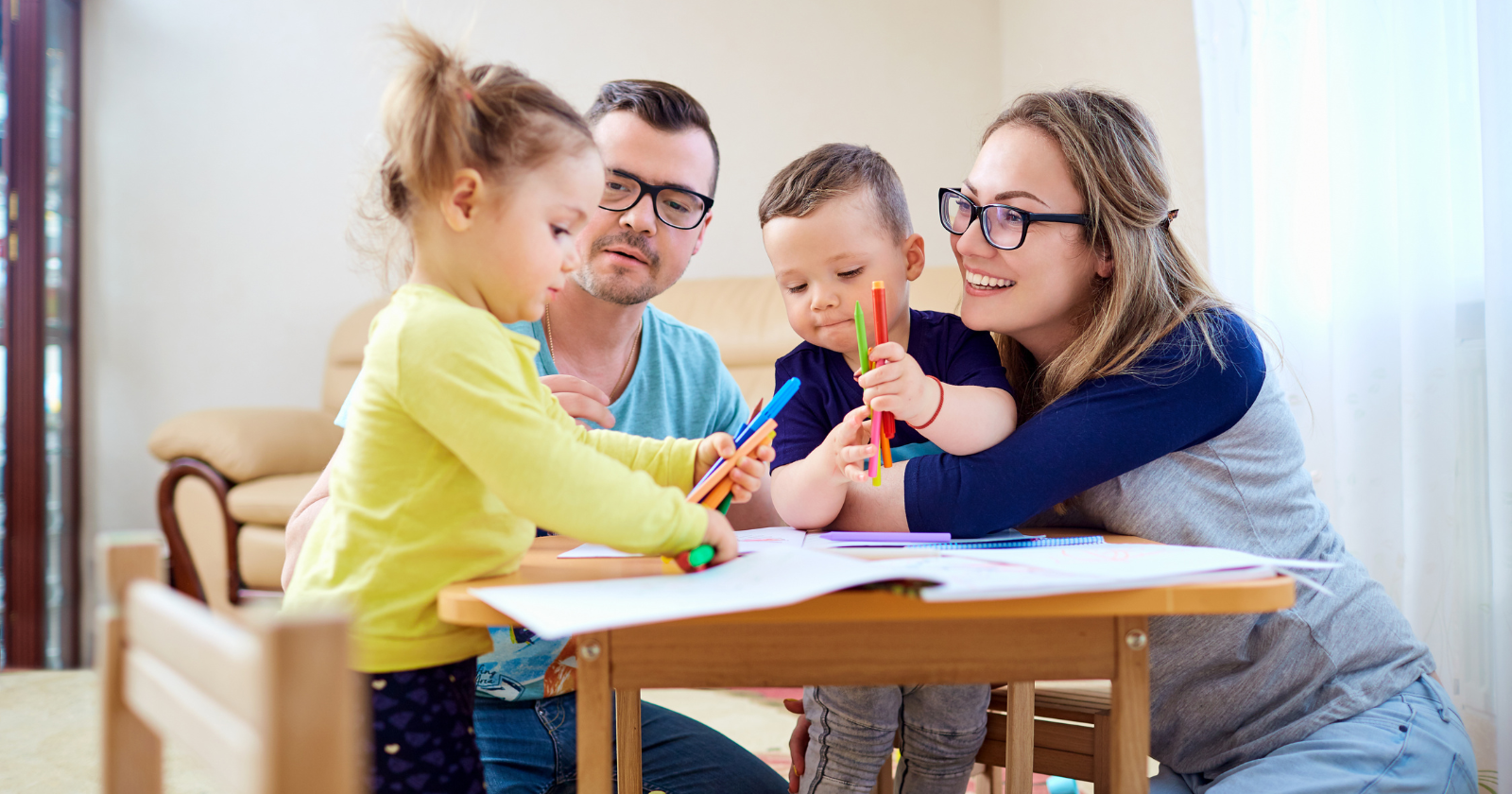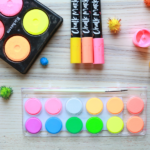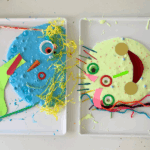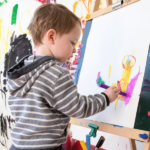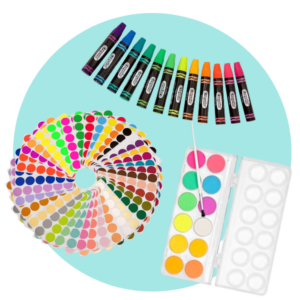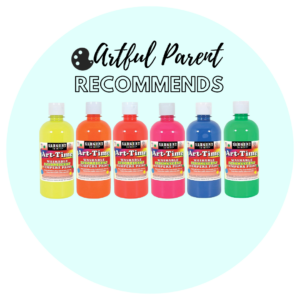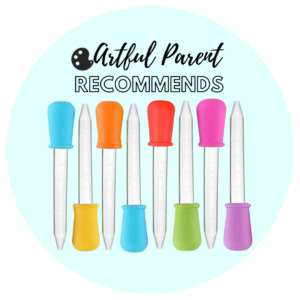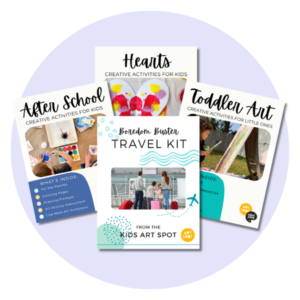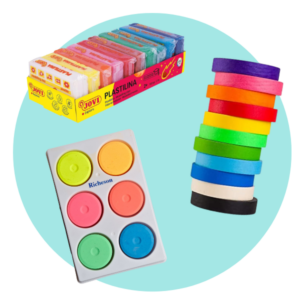Let’s be real, screens are like magnets for kids. The colors, the sounds, the endless scroll, it’s all designed to hook them.
But here’s the catch: those glowing rectangles don’t build patience, problem-solving, or imagination.
As pediatrician Skyler Kalady, MD noted, “Early exposure to excessive screen time at 24 months was predictive of lower developmental outcomes at 36 months”.
That one stuck with me. Because as much as I love a quiet half hour of peace while Elise watches a cartoon, I also want her (and little Julien, eventually) to explore the world beyond the pixels, to make messes, mix colors, and feel the spark of creating something from scratch.
So on weekends, when we’re not at the park or baking banana muffins, we pull out our “project box.”
It’s filled with paint, paper rolls, glue sticks, and random treasures, the building blocks of screen-free fun.
Here are eight of our favorite crafts that are easy to set up, surprisingly low-stress, and guaranteed to buy you real engagement, not just compliance.
1. Paper roll creatures
There’s something magical about turning trash into toys.
Grab those empty toilet paper rolls, a few markers, scraps of paper, and googly eyes. Then tell your kids, “We’re building a zoo.”
Elise loves this one because every animal has a personality. Her latest was a giraffe with pipe cleaner horns named Marzipan. Julien just chews on his roll, but hey, he’s participating.
This craft teaches kids to think in shapes and textures. Cylinders become cats, triangles become ears, and suddenly their imagination runs wild.
And when the creatures are done, we set up a mini “safari” across the living room, complete with jungle sounds from Dad’s mouth.
2. Story stones
Want to spark creativity and calm? Story stones are the perfect combination.
All you need are smooth rocks (we grab ours from neighborhood walks), some paint pens or markers, and an idea. Draw simple symbols like a sun, a house, a dragon, or a rainbow.
Once dry, mix them up and ask your child to pick three. Then say, “Let’s make a story.”
What unfolds is pure wonder. Elise once pulled out a whale, a shoe, and a rainbow and told a five-minute saga about a whale who lost her favorite shoe during a storm.
It’s open-ended play that flexes language skills and imagination, no batteries required.
- People who feel unfulfilled after retirement often have these 10 evening habits - Global English Editing
- 8 clothing habits that quietly reveal you grew up middle class (no matter your bank balance) - Global English Editing
- 7 behaviors that reveal someone wasn’t raised upper middle class but wants to seem like it - Global English Editing
3. Nature collage
One of my favorite Saturday rituals is taking the kids outside after breakfast, bags in hand, saying, “Let’s see what we can find.”
Leaves, twigs, petals, grass, everything becomes part of the art. When we come home, we spread it all on the table and glue it onto recycled cardboard.
This one’s less about the final product and more about the mindfulness of the process. It gets them moving, noticing details, and feeling the textures of the natural world.
As research notes, “Children’s play is anything but trivial – it fuels brain growth, underpins healthy development, strengthens executive-function abilities, helps buffer kids from stress, and deepens the bond between parent and child”.
Every time we do this, I can see it, the calm settling in, the chatter slowing. Even I feel grounded afterward.
4. Salt dough handprints
This one’s sentimental and messy, but worth it.
Mix 1 cup of flour, ½ cup of salt, and ½ cup of water to make your dough. Roll it out, press those tiny hands in, and bake at 200°F for two hours.
Once cooled, the kids can paint them however they want. Elise painted hers bright purple with gold dots. Julien’s was mostly drool art, but that’s part of the charm.
Here’s the thing: it becomes a keepsake, a frozen little moment in time. Every year we redo it, and seeing how their hands grow always hits me right in the chest.
5. Cardboard city
If you’ve ever received an online order (so, basically everyone), you’ve got craft potential stacked in your garage.
Flatten boxes, cut out rectangles for buildings, and hand over crayons or stickers. Ask your kids, “Who lives here?” or “What’s this shop called?”
Then line them up into a “city” on the floor. Add toy cars, tiny people, or LEGO figures.
The creativity that blooms here is wild. Elise once decided her cardboard café only served “air milkshakes” and “invisible sandwiches.” I was promptly charged $500 for one.
It’s role play, engineering, and storytelling in one, and it uses stuff you already have.
6. Sock puppets
This one is pure nostalgia. Remember the sock puppet shows from your own childhood? Turns out, they still work like magic.
Grab some old socks, buttons, yarn, and a glue gun for the grown-up. The kids design their characters. Elise made a sleepy-looking cat, and I helped Julien’s become “Sir Drools-a-Lot.”
Once they’re done, turn the coffee table into a stage. Let them perform, narrate, and giggle their way through improvised stories.
Bonus: It builds emotional literacy. When a puppet “feels sad,” it opens the door to talk about feelings in a fun, low-pressure way.
7. Bubble wrap painting
Okay, this one sounds chaotic, but stay with me.
Take a sheet of bubble wrap, brush it with washable paint, and press paper over it to make textured prints. The colors blend beautifully, and the popping noises keep little hands busy and happy.
We tape up the finished pieces in Elise’s room. She calls it her “gallery.”
And I’ll be honest, these messy, laughter-filled afternoons remind me what parenting is supposed to feel like. Less about keeping things perfect, more about creating shared memories.
As Rudá Iandê wrote in Laughing in the Face of Chaos, “When we let go of the need to be perfect, we free ourselves to live fully, embracing the mess, complexity, and richness of a life that’s delightfully real.”
That line hit home the first time I read it. Because crafts with kids are never neat, but they’re real, and that’s what matters.
8. Homemade instruments
End with a bang, literally.
Use rubber bands, paper plates, and rice-filled containers to make a home orchestra. A tissue box guitar, a shaker, a paper drum, it’s chaos in the best way.
Turn on music and play along, or invent your own songs. Elise loves to lead, shouting “Band meeting!” before we start.
And here’s the secret: this one burns serious energy. By bedtime, they’re usually out cold.
It’s creativity, rhythm, and self-expression, all rolled into one joyful noise.
A few final thoughts
Every craft on this list is simple enough to pull off on a regular weekday afternoon, no Pinterest perfection required.
They’re not just distractions. They’re connection points. Little chances to help kids build focus, creativity, and confidence while we, as parents, slow down long enough to join them in it.
I know how tempting screens can be when you’re juggling dinner, deadlines, and a toddler meltdown. But if we can trade even twenty minutes of that time for a shared craft, the payoff is huge.
It’s in those paint-splattered, glue-covered moments that kids learn patience, collaboration, and joy in the process, not just the result.
And if you ever need motivation, remember this: you’re not doing it for a perfect product, you’re doing it to build memories that last far longer than any app update.
So go ahead, pull out the paper rolls, the glue sticks, the old socks. Make a mess. Make a memory.
The dishes can wait.
Related Posts
-
The Best Arts and Crafts Supplies for Tweens
Fun, colorful arts and crafts supplies that are perfect for the tween in your life.…
-
Fun and Easy Slime Ideas for Kids
Create your very own slime creations for kids with loose parts. These slime ideas are…
-
How to Encourage Creativity, Skills and Confidence for Kids Drawing
Are drawing lessons for kids appropriate for preschoolers? How to encourage drawing skills, confidence, and…


